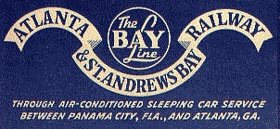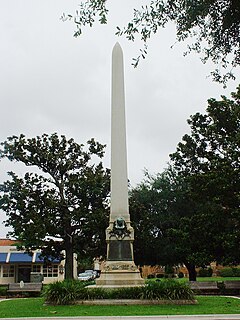Related Research Articles

Dothan is a city in Dale, Henry, and Houston counties in the U.S. state of Alabama. It is the county seat of Houston County and the seventh largest city in Alabama, with a population of 65,496 at the 2010 census. It is near the state's southeastern corner, approximately 20 miles (32 km) west of the Georgia state line and 16 miles (26 km) north of Florida. It is named after the biblical city where Joseph's brothers threw him into a cistern and sold him into slavery in Egypt.

Graceville is a city in Jackson County, Florida, United States. It is near the Alabama state line. The population was 2,278 at the 2010 census. A large portion of Graceville's rural acreage is located in Holmes County, Florida, United States.
The Rutland Railroad was a railroad in the northeastern United States, located primarily in the state of Vermont but extending into the state of New York at both its northernmost and southernmost ends. After its closure in 1963 parts of the railroad were taken over by the State of Vermont and are now operated by the Vermont Railway.

The Southern Railway was a class 1 railroad based in the Southern United States between 1894 and 1982, when it merged with the Norfolk & Western to form Norfolk Southern. The railroad was the product of nearly 150 predecessor lines that were combined, reorganized and recombined beginning in the 1830s, formally becoming the Southern Railway in 1894.

The Atlanta and St. Andrews Bay Railroad, also known as the Bay Line, was a Class I railroad which operated in Alabama and Florida. The company was founded in 1906 and opened its mainline between Dothan, Alabama and Panama City, Florida in 1908. Later reclassified as a short-line railroad, its assets were acquired by the Bay Line Railroad in 1994.

The Alabama and Gulf Coast Railway is a Class II railroad owned by Genesee & Wyoming. It operates 348 miles (560 km) of track from the Pensacola, Florida export terminals, west of downtown, north to Columbus, Mississippi, with trackage rights along BNSF Railway to Amory, Mississippi. A branch uses trackage rights along Norfolk Southern from Kimbrough, Alabama west and south to Mobile, Alabama, with separate trackage at the end of the line in Mobile.

The Central of Georgia Railway started as the Central Rail Road and Canal Company in 1833. As a way to better attract investment capital, the railroad changed its name to Central Rail Road and Banking Company of Georgia. This railroad was constructed to join the Macon and Western Railroad at Macon, Georgia, in the United States, and run to Savannah. This created a rail link from Chattanooga, on the Tennessee River, to seaports on the Atlantic Ocean. It took from 1837 to 1843 to build the railroad from Savannah to the eastern bank of the Ocmulgee River at Macon; a bridge into the city was not built until 1851.

William Dudley Chipley was an American railroad executive and politician who was instrumental in the building of the Pensacola and Atlantic Railroad and was a tireless promoter of Pensacola, his adopted city, where he was elected to one term as mayor, and later to a term as Florida state senator.
The Chattahoochee and Gulf Railroad was a short line railroad operating from 2003 to 2006 between Columbus, Georgia and Dothan, Alabama, on former Central of Georgia and Norfolk Southern tracks. Initially the railroad was a subsidiary of Gulf and Ohio Railways. In 2006, the railroad was acquired by Genesee & Wyoming Inc. and combined with the adjacent H and S Railroad out of Dothan to form the Chattahoochee Bay Railroad.

The Arkansas, Louisiana and Mississippi Railroad is a 52.9-mile (85.1 km) short-line railroad in northern Louisiana and southern Arkansas. Opened in 1908, it has undergone several corporate reorganizations, but has remained independent of larger carriers. In 2004, paper producer Georgia-Pacific sold the company to shortline operator Genesee & Wyoming Inc. Traffic generally consists of lumber, paper, forest products, and chemicals.

The Mobile and Ohio Railroad was a railroad in the Southern U.S. The M&O was chartered in January and February 1848 by the states of Alabama, Kentucky, Mississippi, and Tennessee. It was planned to span the distance between the seaport of Mobile, Alabama and the Ohio River near Cairo, Illinois. On September 13, 1940 it was merged with the Gulf, Mobile and Northern Railroad to form the Gulf, Mobile and Ohio Railroad.
The following is a brief history of the North American rail system, mainly through major changes to Class I railroads, the largest class by operating revenue.

The Pensacola and Atlantic Railroad (P&A) was a company incorporated by an act of the Florida Legislature on March 4, 1881, to run from Pensacola to the Apalachicola River near Chattahoochee, a distance of about 160 miles (260 km). No railroad had ever been built across the sparsely populated panhandle of Florida, which left Pensacola isolated from the rest of the state. William D. Chipley and Frederick R. De Funiak, both of whom are commemorated in the names of towns later built along the P&A line, were among the founding officers of the railroad company.

The Potomac, Fredericksburg, and Piedmont Railroad (PF&P) was a 3 ft narrow gauge short-line railroad in central Virginia that operated between Fredericksburg and Orange, Virginia. It operated until 1926, when its track was sold. A one-mile portion of the former PF&P line continued to be operated as the Virginia Central Railway until the early 1980s. The track has since been removed.
The Selma and Meridian Rail Road Company was incorporated under special act of Alabama on February 7, 1850 as The Alabama and Mississippi Rivers Rail Road Company. On November 29, 1864, the name of the company was changed to The Selma and Meridian Rail Road Company.

Manistee is an unincorporated community in Monroe County, Alabama, United States. Manistee was a logging town, and was home to the Manistee Mill Company, Bear Creek Mill Company and Runyan-Burgoyne Lumber Company. The Manistee Mill Company built a spur track to connect the saw mills of Manistee with the Louisville & Nashville Railroad in Repton and named it the Manistee & Repton Railway. The railway began operations in 1907 and remained in use until the 1970s, operating over 45 miles of track. Amasa Coleman Lee, father of Harper Lee, served as financial manager for a Monroeville law firm's interests in the Manistee & Repton Railway. A post office was operated in Manistee from 1892 to 1912.

The Tuskegee Railroad was a 5 and 1/2 mile long railroad that connected Tuskegee, Alabama to the Montgomery and West Point Railroad at the nearby village of Chehaw. First constructed in 1860 by the Tuskegee Rail Road Company, it was subsequently destroyed in the American Civil War and then sold to E. T. Varner & Company, which rebuilt it and reincorporated it as the Tuskegee Railroad Company in 1872. Again incorporated in 1902 as the Tuskegee Railroad, one of the railroad's primary purposes in the early 20th century was to connect the Tuskegee Institute to other railroad lines.
The Alabama Central Railroad Company was incorporated under the general laws of Alabama on June 22, 1871, by certificate of incorporation dated June 21, 1871.
The Alabama, Florida and Gulf Railroad ran from Ardilla, Alabama to Greenwood, Florida. The line started as a logging railroad owned by the E.L. Marbury Lumber Company of Dothan, Alabama, running from Ardilla to Malone, Florida, where the company had a sawmill. Marbury Lumber incorporated the railroad as the Alabama, Florida and Southern Railroad in 1910. The railroad was sold in 1917 to W. S. Wilson, who changed its name to the Alabama, Florida and Gulf Railroad, and extended the track from Malone to Greenwood. The railroad was placed in receivership in 1924 and sold after foreclosure to the Bank of Dothan. The bank was in turn placed in receivership. The railroad was sold for US$10,000 in 1936, and the name was changed again to the Alabama and Florida Railroad. The primary motive power left on the railroad was a diesel railbus. The railroad ceased operation in 1941 and the equipment was sold for scrap.
The Tampa and Jacksonville Railway was a railroad in North Central Florida in the first half of the 20th century, with a length of 56 miles (90 km) at its greatest extent. It operated under several names in the half century of its existence.
References
- "Untitled". The Pine Belt News. October 31, 1901. Retrieved August 11, 2020.
- ↑ United States. Interstate Commerce Commission (1927). Interstate Commerce Commission Reports: Reports and Decisions of the Interstate Commerce Commission of the United States. U.S. Government Printing Office. pp. 151–162.
- ↑ United States. Interstate Commerce Commission (1940). Interstate Commerce Commission Reports: Reports and Decisions of the Interstate Commerce Commission of the United States. L.K. Strouse. pp. 264–.